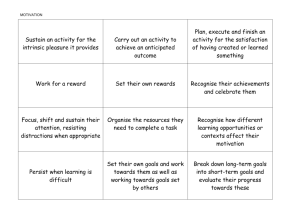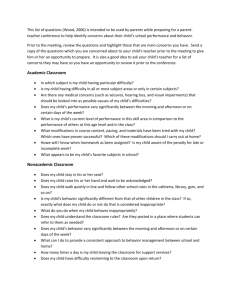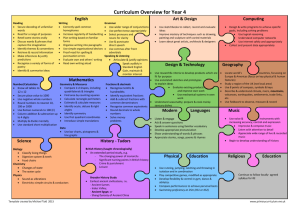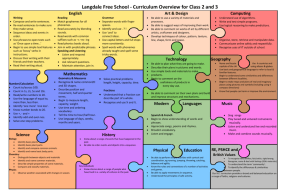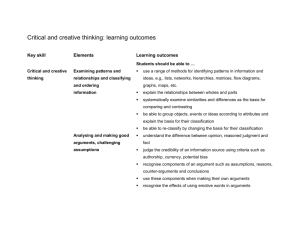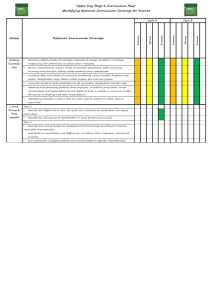Neonatology Curriculum - London School of Paediatrics
advertisement
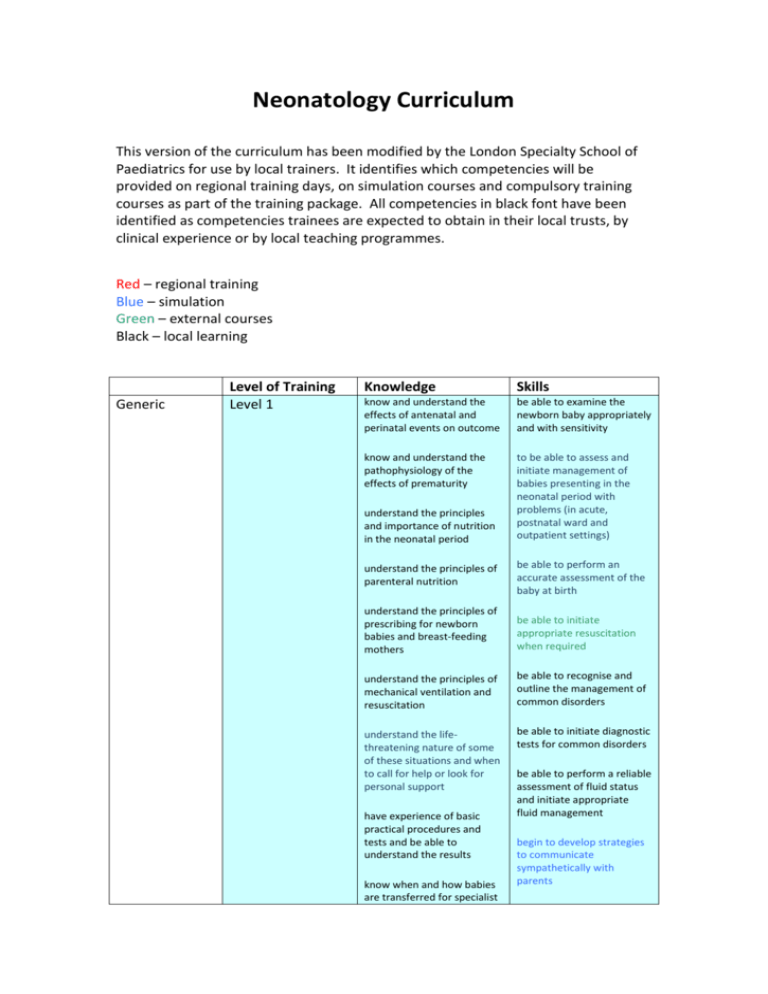
Neonatology Curriculum This version of the curriculum has been modified by the London Specialty School of Paediatrics for use by local trainers. It identifies which competencies will be provided on regional training days, on simulation courses and compulsory training courses as part of the training package. All competencies in black font have been identified as competencies trainees are expected to obtain in their local trusts, by clinical experience or by local teaching programmes. Red – regional training Blue – simulation Green – external courses Black – local learning Generic Level of Training Level 1 Knowledge Skills know and understand the effects of antenatal and perinatal events on outcome be able to examine the newborn baby appropriately and with sensitivity know and understand the pathophysiology of the effects of prematurity to be able to assess and initiate management of babies presenting in the neonatal period with problems (in acute, postnatal ward and outpatient settings) understand the principles and importance of nutrition in the neonatal period understand the principles of parenteral nutrition be able to perform an accurate assessment of the baby at birth understand the principles of prescribing for newborn babies and breast-feeding mothers be able to initiate appropriate resuscitation when required understand the principles of mechanical ventilation and resuscitation be able to recognise and outline the management of common disorders understand the lifethreatening nature of some of these situations and when to call for help or look for personal support be able to initiate diagnostic tests for common disorders have experience of basic practical procedures and tests and be able to understand the results know when and how babies are transferred for specialist be able to perform a reliable assessment of fluid status and initiate appropriate fluid management begin to develop strategies to communicate sympathetically with parents levels of intensive care understand the implications for families of babies with neonatal problems understand the long-term sequelae of prematurity and begin to recognise those at risk Level 2 know about the retinopathy of prematurity and its prevention and treatment know and be able to describe the effects of antenatal and perinatal events on outcome know and be able to describe the pathophysiology of the effects of prematurity understand the principles and importance of nutrition in the neonatal period including assessment of nutritional status, the steps needed to establish breastfeeding, and nutritional supplementation understand the principles of parenteral nutrition and be able to prescribe safely understand the principles of and initiate mechanical ventilation be able to apply clinical reasoning when selecting tests and be able to understand the results sufficiently well to be able to explain them to parents and members of the multidisciplinary team know how to interpret radiological investigations including the basic features of cranial ultrasound and discuss basic findings with parents be able to describe the longterm sequelae of prematurity and recognise those at risk to be able to assess and manage babies presenting in the neonatal period with problems (in acute, postnatal ward and outpatient settings) recognise the lifethreatening nature of some of these situations and the need to call for help or look for personal support be able to initiate diagnostic tests for common disorders and to interpret and explain results to parents be able to perform a reliable assessment of fluid status and adjust fluid management as needed be able to initiate and lead advanced (appropriate) resuscitation when required have successfully completed a neonatal life support course usually be able to obtain appropriate arterial and venous access be skilled in practising and be able to teach basic practical procedures be able to prescribe safely for newborn babies and breast-feeding mothers be able to decide on appropriate referrals for transfer to other units, understand the implications for families of babies with neonatal problems and begin to support them know how to refer appropriately to community services before discharge and begin to participate in the follow up of those at risk know about follow-up programmes for those at risk Birth depression Level 1 be able to describe the ethical issues relating to neonatal intensive care know the causes and possible outcomes know the criteria necessary before perinatal asphyxia can be diagnosed Level 2 understand the physiological effects of a hypoxicischaemic insult know the statistics of the outcomes of birth depression understand the physiology of resuscitation and the responses to it understand the long-term implications of hypoxicischaemic damage Respiratory distress (acute and chronic) Level 1 communicate effectively with all involved and maintain care as safely as possible until transfer team takes over be able to communicate sympathetically with parents and have experience of strategies for dealing with their distress or anger recognise features which suggest significant consequences be able to carry out resuscitation using bag and mask ventilation and cardiac compressions be able to provide and lead basic and advanced resuscitation including intubation be able to intubate preterm babies without direct supervision understand the common causes of respiratory distress be able to recognise and initiate management to prevent secondary damage be able to interpret chest radiographs know the relevant investigations be able to administer surfactant understand the principles and complications of ventilation be able to initiate respiratory support know the guidelines for surfactant therapy understand the pathophysiology and management of chronic lung disease understand the contribution of patent ductus arteriosus to respiratory compromise be able to suspect and diagnose pneumothorax recognise when to request help from a medical or nursing colleague obtain, interpret and act appropriately on blood gas and blood pressure results be able to insert umbilical arterial and venous lines Level 2 understand the principles and complications of differing ventilation techniques be aware of the indications for ECMO and nitric oxide therapies know the images needed and safe positions for arterial and venous lines have seen echocardiography where patent ductus arteriosus is diagnosed be able to identify signs suggestive of patency of the duct and describe management options be able to interpret chest radiographs and act on results be able to initiate and continue to manage respiratory support on a ventilator be able to diagnose pneumothorax and know when chest drainage is indicated recognise when response to management is not optimal and request help from senior colleagues or other services be able to teach and supervise the insertion of umbilical and peripheral, arterial and venous lines be able to identify signs suggestive of patent ductus arteriosus (PDA) and initiate management Cyanosis not of respiratory origin Level 1 Level 2 Hypotension Level 1 Level 2 understand the anatomy and implications of cyanotic congenital heart disease understand the pathophysiology of persistent pulmonary hypertension and know about treatment continuing development of level 1 competencies understand the causes and effects understand the rationale for different treatment options continuing development of know the steps that need to be taken to discharge a baby on long term oxygen to the community be able to suspect the diagnosis and initiate appropriate investigations be able to make a likely diagnosis and initiate appropriate investigations and treatment be able to interpret and act on blood pressure measurements IUGR and other nutritional problems Level 1 level 1 competencies understand the importance of breast feeding understand the principles of parenteral nutrition know the causes of intrauterine and postnatal growth failure know about risk factors for necrotising enterocolitis Level 2 understand the importance of nutrition in sick babies know about the signs, symptoms and complications of necrotising enterocolitis Fluid and blood product therapy Level 1 Level 2 Level 2 be able to prescribe appropriate nutrition and supplements be able to insert a percutaneous long line be able to recognise early signs of necrotising enterocolitis and initiate treatment be able to recognise and begin to address poor growth know the fluid requirements of preterm and sick babies be able to assess appropriate position of percutaneous long line from imaging be able to assess fluid balance know the causes of abnormal coagulation recognise the need for blood product transfusions know the indications for therapy with blood products be able to test for and recognise bleeding disorders be able to act to correct fluid balance abnormalities know the fluid requirements of pre-term, sick and growthrestricted babies know when irradiated blood products are indicated Neonatal Level 1 seizures or abnormal neurological status including the floppy baby be able to keep and interpret accurate growth records understand the aetiology and prognosis of abnormal neurological status know about periventricular haemorrhage and leucomalacia know about the management of posthaemorrhagic hydrocephalus know the possible causes and effects of seizures know the possible causes of abnormal tone be able to prescribe blood product transfusions be able to initiate treatment for bleeding disorders be able to perform a neurological assessment be able to recognise the basic features of cranial ultrasound scans be able to recognise and initiate management of seizures have had some experience of performing cranial ultrasound be able to make a likely diagnosis and initiate management of seizures Severe congenital abnormalities Level 1 understand the underlying pathology understand the use of antenatal diagnosis and the role of fetal medicine be aware of surgical interventions Level 2 Sepsis The dying baby Level 1 know the likely pathogens understand the importance of timely treatment Level 2 know about nosocomial infection understand the importance of timely treatment, know the range of treatments and the likely pathogens Level 1 understand the ethical principles involved Level 2 Jaundice understand the impact on parents of the birth of a baby with serious congenital abnormalities or potential disabilities and the ensuing grief due to loss of the expected normal child understand the role of fetal medicine and interventions that are available Level 1 know about terminal care and bereavement counselling understand the ethical principles in withdrawing or withholding care from an infant understand the investigations that will differentiate between the causes of conjugated and unconjugated hyperbilirubinaemia know the appropriate have experience of how bad news is communicated to parents be able to recognise serious abnormalities be able to initiate appropriate tests be able to respond to parents' immediate questions have participated in interviews where a consultant has given bad news to parents be able to diagnose common syndromes be able to refer appropriately to parent support groups and to community services before discharge recognise early signs of sepsis and initiate therapy appropriately practise effective infection control anticipate early signs of sepsis and initiate appropriate anti-microbial therapy and supportive management be able to communicate sympathetically with parents be able to communicate sympathetically with staff be able to diagnose haemolytic jaundice be able to prescribe phototherapy appropriately recognise features which suggest serious pathology management Level 2 know how an exchange transfusion is performed know the investigations that will diagnose the causes of conjugated and unconjugated hyperbilirubinaemia know how and when to undertake an exchange transfusion Feeding Level 1 understand the importance of breast-feeding know the causes of feeding problems Infants of diabetic mothers Congenital abnormalities Level 2 know the local policies on feeding Level 1 understand the physiology know the likely complications Level 2 know when admission to a neonatal unit is indicated Level 1 know the common diagnoses and the likely prognosis of minor congenital abnormalities Level 2 Disordered development Level 1 know about common presentations of congenital cardiac disease know which congenital cardiac diseases need urgent action know the causes and natural history of conditions causing disordered development understand current theories about the pathophysiology of cerebral palsy* understand the common complications of cerebral be able to manage haemolytic jaundice be able to anticipate the need for an exchange transfusion appropriately be able to undertake a full exchange transfusion under supervision be able to investigate and manage prolonged neonatal jaundice appropriately be able to support and advise breast-feeding mothers be able to identify underlying pathology or faltering growth (failure to thrive) be able to make appropriate recommendations to address feeding problems and faltering growth (failure to thrive) be able to interpret blood glucose estimations be able to initiate appropriate management be able to anticipate problems early and manage appropriately be able to advise parents appropriately recognise when referral to an appropriate specialist is needed be able to ensure that referral to an appropriate specialist or service occurs be able to perform a developmental assessment be aware of the need for involvement of the multidisciplinary team understand the impact of developmental delay on families Level 2 Screening Level 1 palsy and disordered development and how to access expert assessment and management understand current theories about retinopathy of prematurity and sensorineural hearing loss and how these conditions may be prevented ** know the range of screening tests used know about the universal Newborn Hearing Screening Programme understand the difference between a screening and a diagnostic test and the investigations that will follow Level 2 know about developmental dysplasia of the hip know about retinopathy and cataract screening know the management of developmental dysplasia of the hip be able to perform a neurological assessment be able to make a timely and appropriate referral to the multidisciplinary team have seen examples of the effect of developmental difficulties on families be able to explain the implications of a screening test to parents be able to order such tests appropriately be able to examine newborn hips effectively be able to perform clinical screening tests be able to explain the difference between a screening test and a diagnostic test to parents
